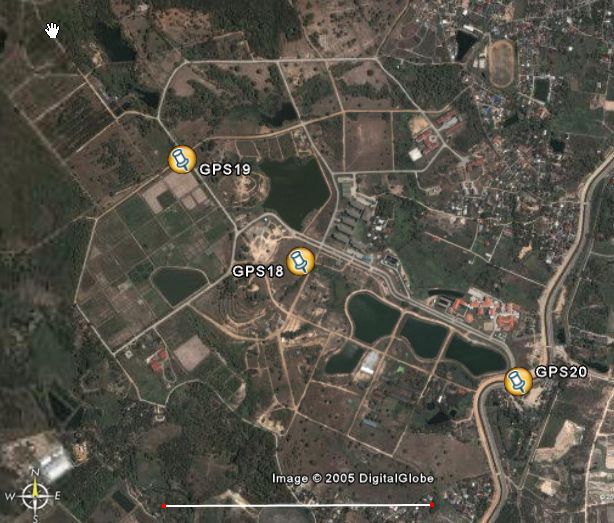| Birding trip report North Thailand Feb./March 2003
John van der Woude - www.jvanderw.nl Logistics: general, maps, addresses, etc. - See also Introduction |
| General
After Malaysia, we chose Thailand
as yet another good and comfortable introduction to SE
Asian birding. The main goal was to see as many lifers (new
species for us) as possible. So we went to the North and
focused on the three well-known mountain sites Doi Chiang
Dao (DCD), Doi Angkhang (DAK) and Doi Intanon (DI). This
was alternated with some lowland sites, and we ended the
trip near Bangkok (Khao Yai NP). This was done by rental
car, which was picked up at Chiang Mai airport and
delivered at Bangkok airport. The planning of this trip was mainly based on the multitude of trip reports available on the internet. Thailand is a popular worldbirding destination, so you'll most probably meet other birders with whom you can exchange information for updates on sites, specialties etc. One of the best trip reports we saw (but we saw it only when we were there already) is on birdinggermany.de Money can be taken from
ATM's (money machines) in every town. We also brought
cash dollars and traveler cheques but did not need them.
In many hotels (but definitely not all!) you can also use
a credit card. The Thai Baht was about 2.2 eurocent/dollarcent. Good maps are for sale in Thailand itself: the Periplus maps (e.g. at the airport bookshops), for different parts of the country. These soon replaced the Thailand map that we had bought at home, and had used for preparing the trip. Thailand is 7 hours ahead
of GMT. We felt safe everywhere,
and only watched our belongings a bit better when we were
on the night market of Chiang Mai. We drove defensively
as in Thailand too the habit is to make a two-lane road
into a three-lane one if needed... But we found the
drivers very polite, which is especially obvious when
they overtake cyclists. Shops are open late and some are also open very early, and there are many of them, so you can stock up at will. Some of the better gas stations also offered much of what we normally need on such a trip, like snacks for lunch, and drinking water of course. Breakfast is not very early in Thailand so we mostly brought something from the shops out in the field. Fuel for the car is rather cheap. We used the new Birds of Thailand by Craig Robson (2002) as our field guide, and our birding gear further consisted of 12x50 and 8x32 Leica binoculars, a Nikon Fieldscope ED (20-45x), and sound equipment (minidisc with reference sounds, cassette recorder for instant recording and playback). Playback was not used very often. |
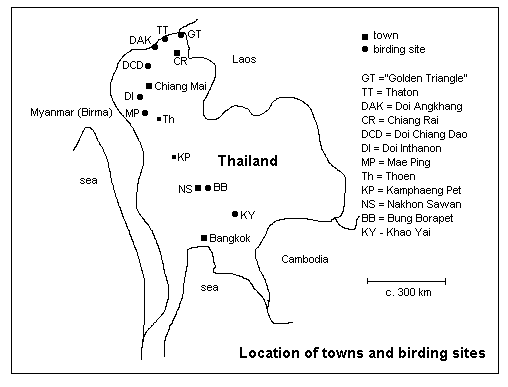 |
|
Itinerary Saturday 22 February 2003 - arrival at Chiang Mai Sunday 23 - Mae Hia & on to Doi Chiang Dao Monday 24 - Doi Chiang Dao Tuesday 25 - Doi Chiang Dao Wednesday 26 - Doi Chiang Dao and on to Doi Angkhang Thursday 27 - Doi Angkhang Friday 28 - Doi Angkhang and on to Thaton Saturday 1 March 2003 - Thaton, Mekong and on to Chiang Mai Sunday 2 - Mae Hia and on to Doi Inthanon Monday 3 - Doi Inthanon Tuesday 4 - Doi Inthanon Wednesday 5 - Mae Ping and on to Bung Borapet Thursday 6 - Bung Borapet and on to Khao Yai Friday 7 - Khao Yai Saturday 8 - Khao Yai Sunday 9 March 2003 - Khao Yai and back to the airport Looking back on this itinerary I don't think we would change it significantly on an other trip. We stayed away from the national parks in the weekends. We did not stay as long in Doi Inthanon as many birders do, but we found it a bit quiet and we had seen many of the species already at Doi Chiang Dao. We did more than one open lowland site (both Mae Hia and Thaton) but did not regret it. Maybe our second visit to Mae Hia (Sunday 2 March) was a bit overdone, but it was either this two-hour visit or nothing at all, as we needed a quiet day. Also, we did not regret to include the Southern sites Bung Borapet and Khao Yai, the latter just because it is so famous and brought back many memories to Malaysia (being more tropical than Northern Thailand). Should we have had one full day more, than we might have visited the Spoon-billed Sandpiper site South of Bangkok, but on the other hand we didn't like the traffic in Bangkok at all and we were glad that coming from Khao Yai to the airport hardly brought us into Bangkok itself as the airport is situated in the North of this metropolis. Also, we liked starting this trip in the North of Thailand and ending in Bangkok, partly in order to have a direct flight back home in stead of first an internal flight (which may be delayed). |
 |
|
Chiang Mai and lowland surroundings We chose the hotel Amari Rincome because of its location near the road to Mae Hia (for early morning birding). This very luxurious hotel is relatively affordable to Western standards (internet booking US$ 60 - www.amari.com; or e-mail rincome@amari.com or phone +66 5322 1130, fax +66 5322 1915). This is your chance to be in a posh hotel for one night or so! For the Green Peafowl site, take obvious entrance to Huay Hong Krai Royal Project (a sort of forest reserve) at 24 km from ring road, to the right. This entrance is at GPS17. Proceed for c. 4 km to sort of gate and drive R on sort of dam, with GPS16 about halfway on the dam itself. After the dam there is a fence at a small parking place (gate open till 18.00 h), walk in for c. 100 m and watch the two cages with peafowls, plus surroundings. The wild Green Peafowls arrived at c. 17.45 h, we stayed inside gate till c. 18.10 h. Others birders see them here in the early morning.
Mae Hia is a really
good open lowland site, not only for introductory
birding, but also because it may be your only chance for
lowland birding. Follow the road along the canal. At GPS20
is a bridge and a manned gate, they'll wave you through (show
your binoculars). At GPS18 we had one of the Birmese
Shrikes. Do also take the road leading to the back of the
site, to R before GPS18. Along this road we had
Indochinese Bush-Lark and Rufous-winged Buzzard, the
latter at GPS19. For the GPS data see the listing at the bottom of this section. The night market should not be missed. This is lively enough at dusk, and you can have a wonderful meal there too. There is a parking place. Drive very slowly on the night market road indicated on the map (compare with larger city map of course), and watch out for small road to the East leading to parking place. Right next to the parking place is also the open restaurant area. Bo Sang is famous for its paper umbrellas, in all sizes, and all with dancing Cranes. Take road into village left when coming from Chiang Mai. There is an obvious P in front of a good shop R after 200 m or so. |
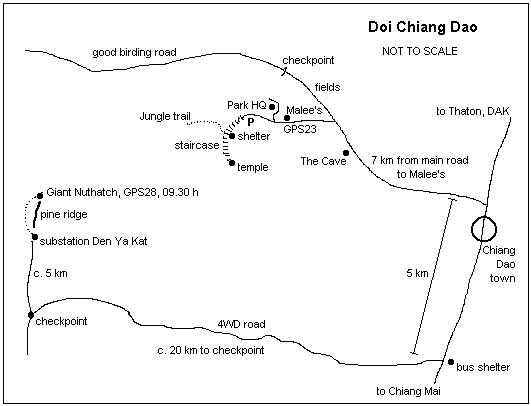 |
|
Doi Chiang Dao (DCD)
- forest at different altitudes
Birders often used to stay at
Malee's Nature Lovers Bungalows and we did so too (but
see below for a newer lodge next to Malee's). Make a
reservation for your bungalow at maleenature@hotmail.com. If you make the reservation long
in advance, reconfirm it a few weeks before going to
Thailand, and also phone her a few days prior to your
arrival (this is a bit of a hassle though). Malee speaks
English and is a good Thai cook. I found the beds rather
hard but if you ask and if there are not too many other
guests, she will give you extra bedding. The evening meal
is communal, at 18.30 h already, which was half an hour
before darkness, so for birders it is a bit too early
alas. To find Malee's, leave the main road at the sign
for The Cave just N of Chiang Dao town. The Cave is a
regional tourist attraction. Our total cost for the stay
at Malee's (3 nights plus evening meals and some other
meals, for 2 persons) was 2350 baht or a bit more than
100 dollar/euro. If you want it still cheaper: there are
also bunk beds. Halfway the steps to the temple is the start of the so-called Jungle trail. The start is not easy to find, but try directly opposite the shelter (see map above). For birding along the road (see photo) North of Malee's and after the checkpoint, we needed (?) a permit from the park headquarters. Along this road we had e.g. Sultan Tit, Black Bulbul and many other forest species, and Chestnut Bunting in the ditch of this forest road. GPS27 was an especially good point, a nice mature forest. At GPS25 you are up in the mixed pine-oak zone. We used the same permit for the visit to the Den Ya Kat area (Giant Nuthatch) on an other day. The stake-out for Giant Nuthatch on the map is not the only one (we also saw them briefly not far after the checkpoint on our way to DYK) but I think it is the most reliable spot. The walk up to this spot along the pine ridge was also worthwhile for other species (like Maroon Oriole and Crested Bunting). For this day we were able to join a trip of an other birder (Gruff) with Rachen Charoennugul as a guide. I can warmly recommend Rachen. His e-mail address is rachen@fnrf.science.cmu.ac.th and mobile phone 0 1950 9109. Rachen did not object at all to my measuring of the GPS-location of the Giant Nuthatch stake-out. |
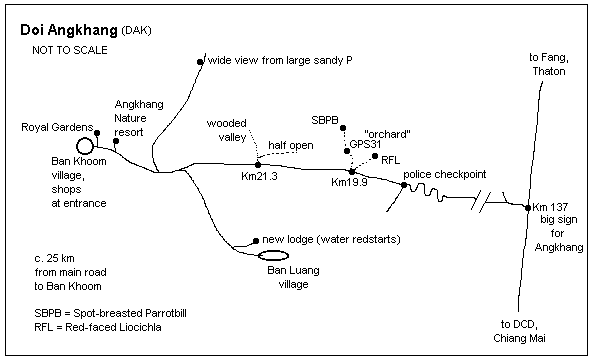 |
|
Doi Ankhang (DAK)
- mountain scrub and some woods
The drive from Malee's to DAK takes
about two hours. The recommended place to stay here is
the Angkhang Nature Resort, a branch of the same Amari
chain of our hotel in Chiang Mai. Although you can see
the details about this Ankhang resort on the same website
(www.amari.com) it was not possible to make a direct
internet reservation. We used e-mail instead: angkhang@amari.com (phone is +66 5345 0110, fax +66 5345 0120).
We had this reservation reconfirmed by the staff of our
Amari hotel in Chiang Mai. We paid US$ 50 for our very
comfortable room (excl. tax). The restaurant is very good
here: some birders have said it was the best they had in
Thailand, and that says something as Thai food is
generally good. The main sites to bird at
DAK are at Km 19.9 ("orchard") and Km 21.3 (see
map). So we had thought that we could manage this in one
long morning only, but we loved the area so much (and did
also need more time) that we stayed for a second night.
Some of our best birds at these two sites were Mountain
Bamboo-Partridge, Red-faced Liocichla, Tristram's
Bunting, Short-billed Minivet, Spectacled Barwing, Spot-breasted
Parrotbill. We found the latter by walking to the left-hand
corner of the "orchard" area of Km 19.9 (at GPS31)
and taking a very narrow trail through the weeds
obliquely upward across the hill side towards some
obvious new orchard-like trees. The total distance from
the road to the parrotbill spot was probably about 300 or
400 m. I got GPS30 at the parrotbill spot but the
satellite coverage was not so good because of the hill. |
 |
|
Thaton -
lowland arable fields and river banks
From DAK to Thaton it's a one hour drive or a bit longer. You do not need to make a reservation for a hotel here, there are many of them. We chose the Thaton River View Resort (phone +66 53 373 173, fax +66 53 459 288) because of its quiet location and nice view over the small Maekok river. All their bungalows face the river. They have a nice restaurant. The rate was about 1100 baht per room. There are plenty of shops in the village. Apparently, in view of the number of hotels here, Thaton attracts quite some tourists. It is well treated in the Lonely Planet guide for Northern Thailand. Thaton is for lowland birding in a maze of arable fields South of town, plus some river bank birding. We had picked up a map with a stake-out for Jerdon's Bushchat. We had no luck with this bird but saw many other trip ticks and lifers at that site, like Black-faced Bunting, Chestnut-capped Babbler, Yellow-bellied Prinia and male Siberian Rubythroat. The JB stake-out is at GPS44 (see map above). See the photos in the
other section for an impression of the scenery at this
site. Some of the best bananas of our trip did we get at
the shop at GPS41. |
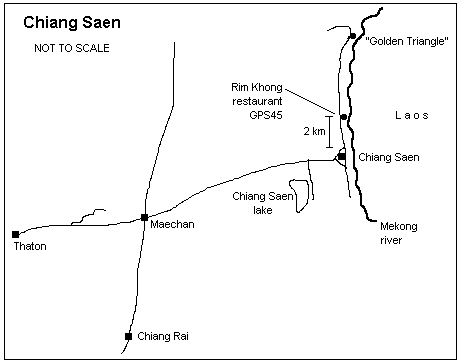 |
|
Chiang Saen
-
Mekong river This
was a bonus site, on our way from Thaton via Chiang Rai
back to Chiang Mai. We got the tip to visit the Rim Khong
restaurant, where you have a splendid view on a large
sandbar in the river Mekong which had Small Pratincole,
Spot-billed Duck and Ruddy Shelduck. Do walk to the front
side of the restaurant to have a better view on the river.
You can do this by walking, underneath a sort of landing,
along the left side of the main part of the restaurant. Only a few km to the North is the "official" tourist trap called the Golden Triangle. There too we had a good view (but less good than at Rim Khong) on a sandbar with again several Small Pratincole. Worthwhile for the scenery alone. At Chiang Saen Lake sometimes (but only sometimes!) Baer's Pochard is seen. For this, you need a boat ride with a mr. Boon Pokh (?) towards the middle of the lake. Even then the birds may not be there (probably depending on the season). This whole visit to the mighty Mekong river only took a few hours extra time (as counted from Mae Chan), including the meal at Rim Khong. |
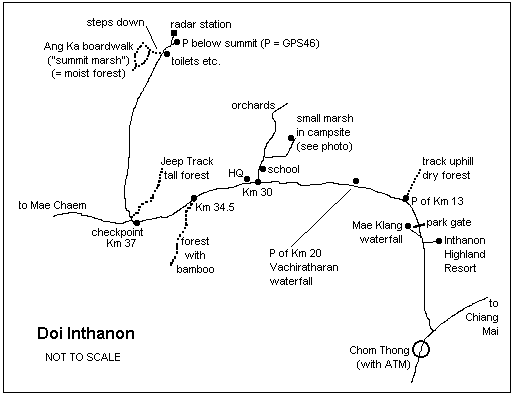 |
|
Doi Inthanon
-
mountain forest The most famous birding mountain in Northern Thailand. We were not lucky on every site here, but the park still gave us 30 species that we did not see at any other site on this trip. The "summit marsh" (actually a moist forest well below the summit) was very good: Chestnut-crowned Laughingthrush, Yellow-bellied Fantail, Chestnut-tailed Minla, Rufous-winged Fulvetta, White-browed Shortwing, Ashy-throated Warbler, Dark-sided Thrush, Gould's and Green-tailed Sunbirds. We saw both cochoas after playback along the Jeep Track (km 37), where we also got Slaty-bellied Tesia and Yellow-cheeked Tit. Do try the Black-tailed Crake at the campsite - use the photo to find the marsh where it may walk around 17.30 h. Inthanon Highland Resort
is the place to stay here. Visit their website if only
for the photos of the bungalows (www.inthanonhighland.com).
It is a great place, very quiet and natural, with good
food. For breakfast and lunch we had brought food from Chiang Mai (Chom Tong would be fine as well). We visited the shop plus food stall of Mr. Daeng near the park's headquarters (he was absent but they provide a birding map), but I am sorry to say that we found the kitchen not inviting enough for a meal. It was good for cool drinks and bananas of course. The road to the top is asphalted all the way and the drive from the entrance to the top takes about 45 minutes. It is best to start with the Ang Ka boardwalk near the summit (the "summit marsh") and then do the lower sites, and on another day start with the lowest sites and proceed to the upper sites like Jungle Trail (Km 37). |
 |
|
Mae Ping
-
open forest on low hills We used this national park as a morning stop on our way South. Even for a few hours you have to pay the 200 baht national park fee. It is said to be good for woodpeckers but then you will need more time. We had Golden-fronted Leafbird, Small Minivet and Black Baza as best birds. We were recommended to walk the first kms of the Tung Gik road (see map). It is a nice and quiet park. This type of very open forest did we see nowhere else. We had a nice chat with a
warden at HQ before leaving. His name is Peak (nickname),
and he seemed to be a good birder (could tell of most
birds in his field guide how rare or common they are in
the park). |
 |
|
Bung Borapet -
marshy lake border in the central lowlands
This lake is often mentioned as a
good stop on your way to the North or down to Bangkok.
Still, we had to find out a lot ourselves and so we made
many GPS-markings and have tried to draw a useful map.
The best site is in the Southeast, where a very nice
reserve with a trail gives ample opportunity to study the
marsh birds at close range. Another possibility is to go
by boat from the Northwest border of the lake. Although
closer to Nakhon Sawan town, this is even harder to find
than the reserve in the Southeast. Study the above map
carefully. Hotel Piman (also written as Pimarn) is a good hotel and probably the best place in this business town (Nakhon Sawan). Find the little side road just N of the pedestrian bridge across the wide Road 1 with divided lanes (so you need a U-turn when coming from the South). The room rate was 800 baht, and they have a restaurant. |
 |
|
Khao Yai -
moist tropical forest This famous national park can be included on your way up to the North or down to Bangkok. While driving on the ever busier roads from the North (Nakhon Sawan, see Bung Borapet) we had to follow the signs for, respectively, Bangkok, Lop Buri, Sara Buri and Nakhon Ratchasima. Keep this in mind because you may easily be diverted to Bangkok again. Along the road from Pak Chong to the park entrance there are several hotels, but we had found the Chalet Hill bungalows on the web ( www.chalethill.com ) and we liked this better than the hotels/lodges we saw along the rather busy and touristy PakChong - park road. We paid 1400 baht per night (internet rate) for a spacious bungalow with a nice veranda and garden. It is set in a quiet and enclosed residential park with vacation homes for rich people from Bangkok I guess. Their restaurant is not open in the evening but there is a lovely Thai restaurant called Toscana along this same side road (see map). The shops in the village near Chalet Hill have plenty of food stuff. Chalet Hill is only 10 minutes from the park entrance. Dome was the name of the kind young lady who helped us here and she speaks reasonably English. Our e-mail correspondence was easy (chalet@chalethill.com) and better than the use of their web form. They asked for a 30% payment in advance but I could make clear that this would be rather difficult from Holland so they kept the reservation for me anyway. During Thai vacations this may be different of course. You have to pay cash baht at Chalet Hill. In Pak Chong there is a brand new and modern bank office on the left after entering the town, with a cash machine (ATM). We did most of our birding here along the trails near the headquarters, between Km 33 and Km 38 of the asphalted park road. The trails have been renumbered on the leaflet maps etc. you will receive. So the famous trail "6" is now trail 5 (to make life easier). See the daily report how we did on the different trails here. It was not easy birding! We found the present state of the campsite not so good for birding. It has been expanded and upgraded. We had our Coral-billed Ground-Cuckoo not here but along trail 5 (new number), see the daily report for more details. Do not miss the show of the bats! See the map where you should be, and read the daily report for 6 March how this actually goes. Be there between 18.00 and 18.30 h (in March). The food stalls near HQ
were just OK. We also brought our own food stuff from the
shops near Chalet Hill. |
GPS waypoints taken on this trip See maps and descriptions above. Locations in WGS84, in degrees, minutes, seconds. W = waypoint. Read "W 016" as "GPS016" in the maps and texts above W 016 N18°52'44,79" E099°12'58,70" W 017 N18°54'32,35" E099°13'01,00" W 018 N18°45'38,49" E098°56'04,23" W 019 N18°45'50,79" E098°55'49,13" W 020 N18°45'24,74" E098°56'32,00" W 021 N18°48'19,49" E098°57'38,91" W 022 N18°48'00,66" E098°58'04,12" W 023 N19°24'11,66" E098°55'33,94" W 024 N19°24'49,38" E098°50'08,04" W 025 N19°25'04,52" E098°51'04,06" W 026 N19°24'49,92" E098°51'30,20" W 027 N19°24'39,70" E098°52'53,43" W 028 N19°22'44,61" E098°50'26,99" W 029 N19°52'33,06" E099°03'14,48" W 030 N19°51'53,03" E099°03'13,61" W 031 N19°51'50,94" E099°03'10,92" W 032 N20°02'42,10" E099°22'57,72" W 033 N20°02'50,40" E099°22'47,39" W 034 N20°02'45,15" E099°22'18,44" W 035 N20°02'45,38" E099°22'11,62" W 036 N20°02'47,62" E099°22'08,01" W 037 N20°02'52,62" E099°22'01,81" W 038 N20°03'24,43" E099°22'01,41" W 039 N20°03'27,91" E099°21'50,26" W 040 N20°03'31,42" E099°21'51,46" W 041 N20°03'35,82" E099°21'41,03" W 042 N20°03'43,49" E099°21'45,40" W 043 N20°03'53,63" E099°21'37,33" W 044 N20°02'47,08" E099°23'02,10" W 045 N20°18'12,66" E100°05'31,81" W 046 N18°35'15,50" E098°28'53,03" W 047 N18°31'30,75" E098°39'06,68" W 048 N15°42'40,96" E100°11'19,60" W 049 N15°43'23,52" E100°11'02,84" W 050 N15°40'15,68" E100°14'34,50" W 051 N15°38'19,11" E100°14'10,86" W 052 N15°40'10,60" E100°07'40,80" W 053 N15°42'08,05" E100°07'08,40" W 054 N14°31'57,34" E101°21'31,37" W 055 N14°32'01,65" E101°21'28,48" W 056 N14°31'00,59" E101°23'14,32" |
